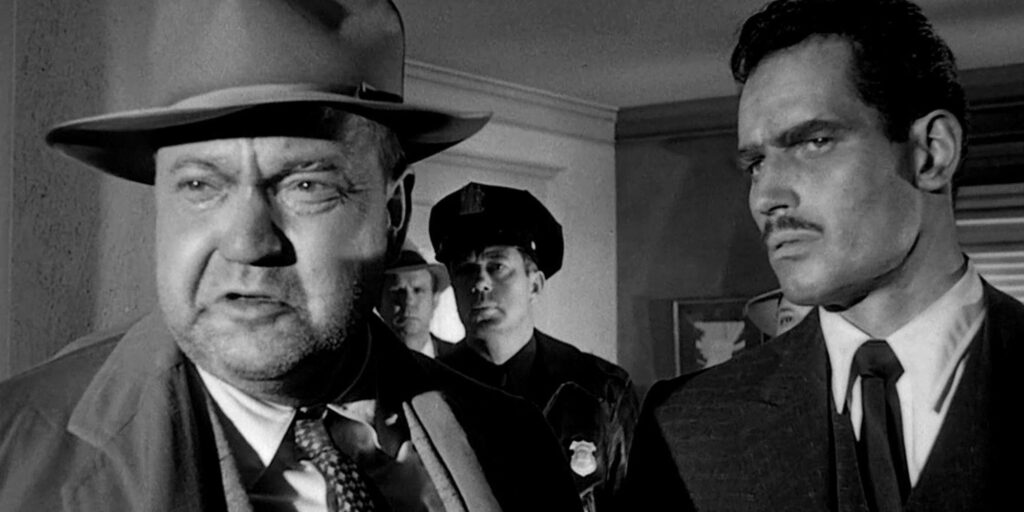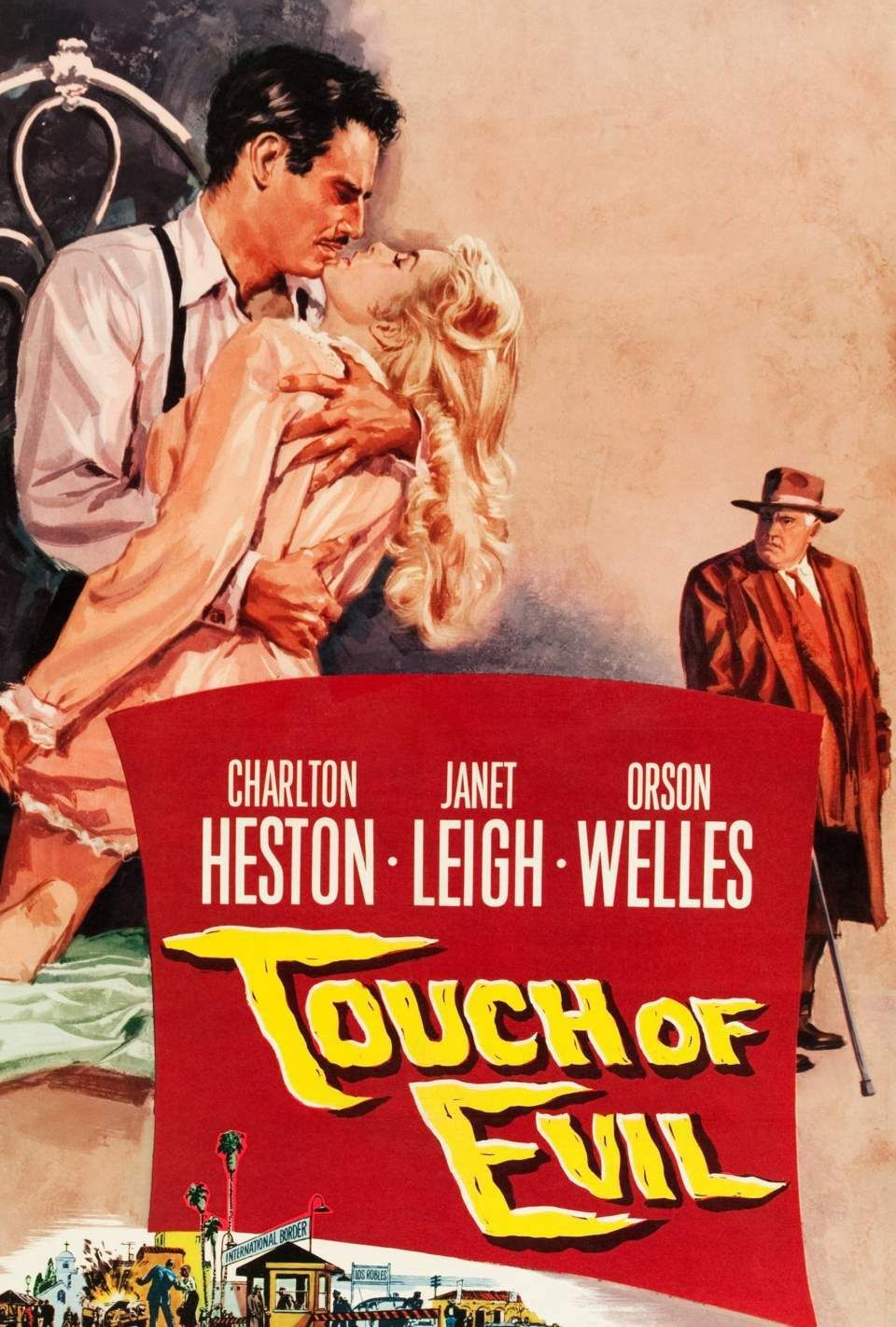With 97% On RT, Charlton Heston & Orson Welles’ Only Movie Together Is One Of The Best Film Noirs Ever Made

In 1957, arguably the biggest star in Hollywood got together with cinema’s most revered director to make a movie called Touch of Evil. Upon its release the following year, the movie would become one of the all-time great film noirs and a touchstone for the revivalist neo-noir genre a decade later. Orson Welles cast Charlton Heston, at that time the world’s most successful actor, as the lead in his movie immediately after Heston’s appearance in blockbuster historical epic The Ten Commandments. The pairing proved to be a match made in film noir heaven.
Welles then added Janet Leigh, the future star of the legendary shower scene in Alfred Hitchcock’s Psycho, and Hollywood legend Marlene Dietrich into the mix, and set about making a masterclass in noir cinema. Touch of Evil features the kind of visual innovations audiences had come to expect from Welles. However, in this case, the pioneering elements of the film were in service of a pre-existing genre, of which Touch of Evil is perhaps the most perfect example ever created. The movie is a love letter from Welles to film noir and one that only he could have written.
What Touch Of Evil Is About
A Crime Movie Full Of Misdirection & Malice
Touch of Evil is a dark crime movie that ultimately differentiates an evil deed from an evil person, via a disorientating thrill ride through the moral ambiguities and misdirection of noir cinema. Its inciting incident is a car explosion at the US-Mexico border, which forces Charlton Heston’s Mexican prosecutor, Ramon Miguel Vargas, to cancel his honeymoon and work on finding the culprit. A sinister police detective named Hank Quinlan, who’s played by Orson Welles, is in charge of the case, but Vargas and his new wife begin to notice something suspicious about Quinlan’s approach.
.JPG)
Related
Charlton Heston’s 10 Best Movies, Ranked
Over the course of his 60 year career in movies, Charlton Heston starred in many iconic and important movies. Here are 10 of his best films, ranked.
From its extended opening shot to its powerful closing sequence, Touch of Evil is imbued with a sense of malice and foreboding that never fully dissipates, even in the movie’s action-packed finale. Almost all of its major characters are touched by evil in one way or another, as we’re left with the overwhelming sense that moral definitions of people aren’t as clear-cut as they seem, including in the case of the overtly malevolent Quinlan.
Touch Of Evil Proves Why Orson Welles Is One Of The Greatest Directors Ever
The Movie’s Opening Scene Alone Is Among The Best Works Of Suspense In Film History
The greatest cinematic masterpiece by writer-director Orson Welles since his debut feature film, Touch of Evil achieves things that not even the so-called greatest movie ever made Citizen Kane dared to attempt. It begins with a three-minute tracking shot taken from a crane that the team behind Netflix’s one-shot series Adolescence would have been proud of, 67 years later. This shot tracks a car that has a time bomb hidden in its trunk, as it slowly makes its way through the busy streets of a Mexican border town.

Related
Every Orson Welles Movie, Ranked Worst To Best
Orson Welles is one of the most significant filmmakers who ever lived, with several of his movies revolutionizing the shape & scope of modern cinema.
Only we, the audience, are aware the bomb is there, a dramatic conceit that builds tension in a manner not even the great master of suspense, Alfred Hitchcock, managed to accomplish. Elsewhere, Touch of Evil employs various other visual motifs from Welles’ dazzling array of cinematic tricks, including his trademark low-angled camera shots, and one of the first scenes in movie history to be filmed from the front of a moving car. By the end of the story, we’re left with no doubt that Welles was one of the best directors of all time.
Touch Of Evil Perfectly Exemplifies What A Film Noir Is Supposed To Be
It Offers Up Perfect Examples Of Virtually Every Noir Trope
The noir genre was already well-established by the time Welles made Touch of Evil, but he clearly wanted to produce a movie that would be regarded in historical terms as a definitive work of film noir. The director unquestionably succeeded in his aim, as his film offers up perfect examples for virtually every noir trope. Tonally, Touch of Evil is ominous and unnerving throughout, engendering in its audience the idea that the world is a darker place than it appears to the casual observer.
Touch of Evil brilliantly subverts the roles of classic film noir detectives like Sam Spade and Philip Marlowe, by making Quinlan a wholly corrupt and reprehensible figure, with a physical resemblance to the gangsters played by specialist noir actor James Cagney.
Welles underscores the movie’s murky atmosphere by shooting it in high-contrast black-and-white and lighting it in a way that plays up the shadowy nature of its themes. However, Touch of Evil‘s most obvious nod to the noir genre is its characterization of Hank Quinlan, a fedora-clad, hard-boiled police detective. He brilliantly subverts the roles of classic film noir detectives like Sam Spade and Philip Marlowe, by making Quinlan a wholly corrupt and reprehensible figure, with a physical resemblance to the gangsters played by specialist noir actor James Cagney.
Yet, in typical noir fashion, even Quinlan’s morality turns out to be multi-faceted, with his evil persona counterposed to his brilliance as a detective in Touch of Evil‘s last lines of dialogue. Marlene Dietrich’s superb cameo in the movie’s epilogue is a final flourish befitting a work that’s rightly gone down in history as the high benchrmark of noir filmmaking.








